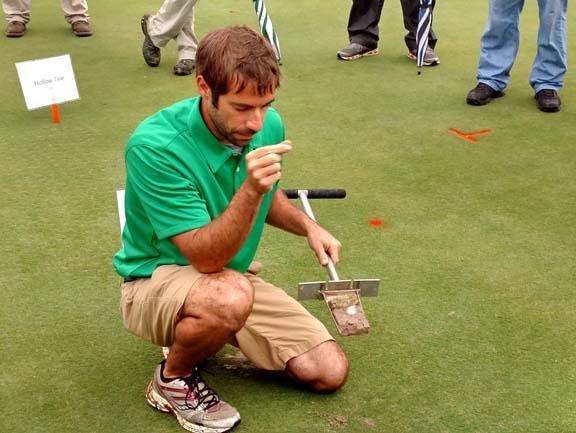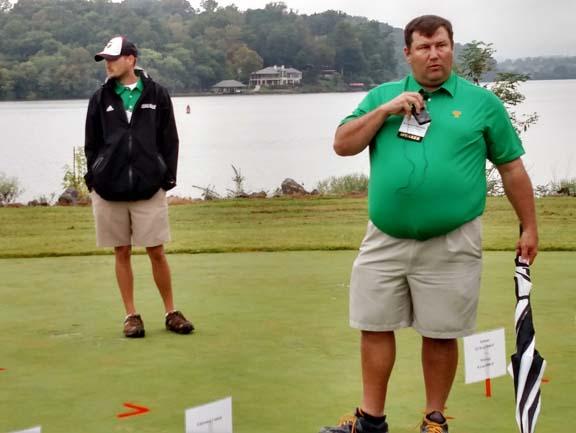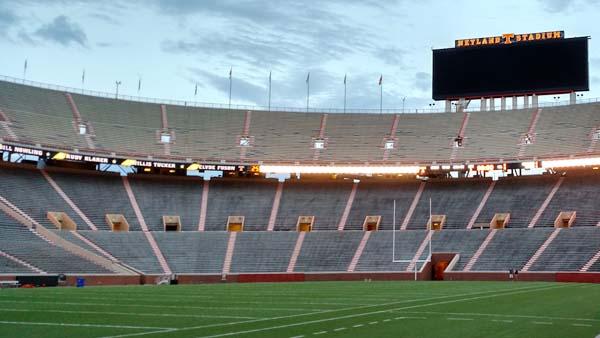
The University of Tennessee turfgrass program has come a long way during the past dozen years.
In fact, John Sorochan, Ph.D., couldn't help but smile as he scanned the East Tennessee Agriculture Research and Education Center during this year's UT Turfgrass Research Field Day, and thought about just how much the program has progressed since he came aboard in Knoxville in 2002 after earning a doctorate degree at Michigan State.
"None of this was here then," Sorochan said of the acres of turf research projects under management at the East Tennessee research center. "Back then, it was just me and Tom Samples doing extension work."
Whether it's an increase in the amount of scientific research that is being conducted at UT, growing enrollment in the undergraduate turf program, a growing turf research field day, constant program tweaking designed to drive attendance at the annual winter conference or an innovative internship program that gives UT students an advantage over counterparts from many other schools, there is a lot of excitement and enthusiasm surrounding Tennessee's turfgrass management program in Knoxville.
"We want to make things bigger, and expand the reach of the 'T' to a wider audience," said Jim Brosnan, Ph.D., who has been at UT since 2008. "There is a lot of pride in the 'T'."
Sorochan recalled that when he came to Tennessee 13 years ago the only space he had to conduct research trials was in his office.
Back then, during the waning days of the golf course construction boom, about three-dozen students were enrolled in the program. As the golf market began to scale back, so did the number of students in the program, to the point that it hovered around 15 for several years, and even dipped to as few as nine students a just a couple of years ago.
Indeed, a lot has changed.
While enrollment at many other turf programs still is on the decline and some programs are on the verge of closing, the number of students in training to be golf course superintendents or sports turf managers is on the rise in Knoxville. This year, about 40 undergraduate students are enrolled in turf studies at the University of Tennessee. It's no coincidence that in that time, the university has become is a global leader in peer-reviewed research that influences management programs throughout the country and around the world and is growing each day.
The reasons for the growth of the UT turf program were many, including support from university administration, a young and energetic faculty that works hard to connect with younger students, embraces new technology and is always looking for ways to stay ahead of a rapidly changing market.
The university has become a leader in fields such as Bermudagrass management research, weed science, extension and education, both of students and superintendents in the field.
About half of those undergraduates are new to the program this year. A handful, about five or so, are traditional incoming freshmen, while the rest are UT undergrads who changed their major or transferred in from a community college.
"The UT turf program is a tremendous feather in the cap of Tennessee," said Paul Carter, CGCS at The Bear Trace at Harrison Bay near Chattanooga and the current president of the Tennessee Turfgrass Association. "I see a lot of what they do behind the scenes, and there is nothing status quo about the UT turf program. They are always looking to see what is the next big thing and how they can be in front of it."
The department, with help from the college of agriculture, hired The Tombras Group, a market research firm based in Nashville, to help learn the issues that are important to college students when making decisions about what to study and where to attend.
"We investigated why enrollment was trending down, and we found a couple of things that were important," said Brandon Horvath, Ph.D., turfgrass pathologist at UT since coming over from Virginia Tech in 2009. "Visibility was an issue, as was the number of students. It's not that there aren't plenty of students in interested in turf, but the talent pool is what it was 30 years ago. Those students are all doing something else, which makes them harder to find. They are playing golf at a high level in high school, or they are playing soccer. And sports aren't seasonal like they used to be. Everything is a year-round sport now.
"Those students still exist. We just have to become more visible to them."
I see a lot of what they do behind the scenes, and there is nothing status quo about the UT turf program. They are always looking to see what is the next big thing and how they can be in front of it."
Social media (@UTTurfgrass) has played a major role in increasing that visibility among prospective students and attracting them to the program.
"I started here in 2011, and the numbers were kind of dwindling. I thought 'great, are we even going to have a turf program?' " said Cory Yurisic, a UT turf graduate who is pursuing a master's degree at the school. "Here in the last two years the numbers have skyrocketed. A lot of that is because of social media. Jim is big on that."
The way UT approaches it internship program also has been a benefit for students.
Developed by Sorochan several years ago, the program includes a concentrated block of classes during the spring semester, in which juniors and seniors complete a full load of classes in eight weeks rather than 15. That means upperclassmen are out of school and available for internships in late February or early March, and that has been especially attractive to Major League and Minor League baseball franchises.
"When I call the Boston Red Sox and they tell me they are going to take four or five interns, but they have 35 applicants, they listen when I tell them ours will be there a full month before Opening Day," Sorochan said. "Instead of taking one of our students, they take two. It's the same with the Baltimore Orioles.
"Now, we have people calling asking for UT students."
 The program also has taken a fresh look on educating turf professionals from throughout Tennessee and from surrounding states.
The program also has taken a fresh look on educating turf professionals from throughout Tennessee and from surrounding states.Brosnan, who heads UT's weed science and extension efforts, is responsible for programming both for the research field day and annual turf conference, both held in conjunction with the Tennessee Turfgrass Association.
In an effort to drive attendance at this year's field day, he brought in unique educational sessions and demonstrations with a hope of attracting north of 500 attendees.
Although the event was plagued throughout the day by heavy rain, the result was some 530 attendees who showed up to learn about topics such as aerification options that included DryJect and the Air2G2, Bermuda management tactics that included a fraze mowing demonstration by Campy Turf Care Systems utilizing the Koro Field Top Maker, managing creeping bentgrass in the transition zone, information on the southward advancement of emerald ash borer and a slew of programming specific to the lawn and landscape market.
"It's a collective group effort," Brosnan said. "We all try to get a feel for the pulse of the issues that are at the forefront of the turfgrass community in Tennessee. One of the things we are now looking at is off-type grasses in ultradwarf putting greens. That surfaced at an isolated level three years ago. Since then, we've done more research on it and promoted it, and more superintendents are finding out that it's more of an issue than they thought before. We also do work on herbicide-resistant weeds. We try to get out in front of issues like that and communicate to people that it is a problem, that they need to be aware of it and what are the best ways to manage it."
Changes are ahead for next year's field day, which will be moved off campus to The Little Course in Franklin, just outside Nashville, to cater to turf managers in parts of the state in the Central Time Zone.
"The message is that we can go to a larger metropolitan area and to a new audience and potentially grow this even more," Brosnan said. "And when we come back to Knoxville in a couple of years, maybe the numbers go up. For folks in Nashville and Memphis, to drive over here to Knoxville and lose an hour, that's a big ask. If we can demonstrate our value in those markets, it might be more likely to help continue growth."


